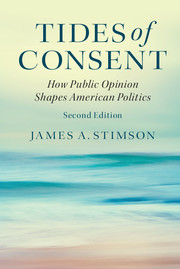Book contents
- Frontmatter
- Contents
- List of Figures
- List of Tables
- Preface to the Second Edition
- Preface to the First Edition: The Shutdown
- Acknowledgments
- 1 Opinion Flows
- 2 What the Public Wants of Government
- 3 Left and Right Movements in Preference
- 4 The Great Horse Race: Finding Meaning in Presidential Campaigns
- 5 Between the Campaigns: Public Approval and Disapproval of Government
- 6 On Politics at the Margin
- Bibliography
- Index
3 - Left and Right Movements in Preference
Published online by Cambridge University Press: 05 September 2015
- Frontmatter
- Contents
- List of Figures
- List of Tables
- Preface to the Second Edition
- Preface to the First Edition: The Shutdown
- Acknowledgments
- 1 Opinion Flows
- 2 What the Public Wants of Government
- 3 Left and Right Movements in Preference
- 4 The Great Horse Race: Finding Meaning in Presidential Campaigns
- 5 Between the Campaigns: Public Approval and Disapproval of Government
- 6 On Politics at the Margin
- Bibliography
- Index
Summary
In 1972, a year before the famous Roe v.Wade Supreme Court decision on abortion, a woman seeking a therapeutic abortion faced a much different situation. Abortion was illegal in nearly all jurisdictions. But one state at a time, things were changing. State legislatures were liberalizing the law to recognize the reality of medical practice at the time. Women were having safe legal abortions because doctors supported their decisions and, to skirt the law, were willing to call the procedure something else.
When the states acted, they faced organized opposition from the Roman Catholic Church. On the other side were physicians and old-line organizations supporting family planning such as Planned Parenthood, then not a great deal more controversial than the Girl Scouts. The public support for abortion liberalization was not known as well as it is now; it was not as controversial as it now is. But it seems clear that large numbers of supporters were women, women who were well educated, played tennis or golf at the club, and voted for the Republican Party. Support for abortion (and family planning generally) came, that is, from the part of America that had higher incomes, was better educated, and lived in suburbs. These are descriptions that are roughly accurate also for the Republican Party.
Support for abortion rights in 1972 was not “liberal” and definitely not Democratic. The Democrats were then more solicitous of the views of the Catholic Church, which had long been if not an ally then at least the religious home of many of the ethnic voters who were Democrats. Abortion was firstly a medical issue and secondarily a religious one. The action was in the states, and the issue drew little attention in national politics. The two political parties pretty much ignored it. If we had known in 1972 that abortion would come to divide the parties, a guess that the Republicans would be pro-choice and the Democrats pro-life might have been at least as plausible as the alternative.
When delegates to the Republican National Convention met in August 1972 to renominate Richard Nixon, fully 69% of them expressed themselves in favor of abortion rights. These faithful Republicans, the hardest of the hardcore, the purest of the pure, did not see any conflict between freedom from government regulation of abortion rights and the freedom from regulation that was their traditional position toward business and the economy.
- Type
- Chapter
- Information
- Tides of ConsentHow Public Opinion Shapes American Politics, pp. 52 - 84Publisher: Cambridge University PressPrint publication year: 2015



